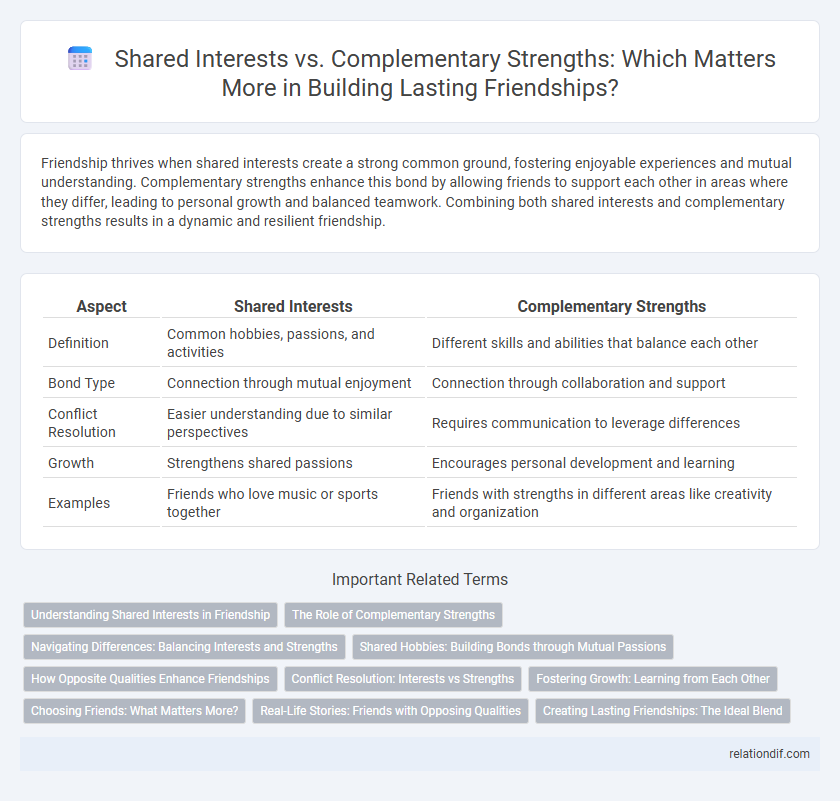Friendship thrives when shared interests create a strong common ground, fostering enjoyable experiences and mutual understanding. Complementary strengths enhance this bond by allowing friends to support each other in areas where they differ, leading to personal growth and balanced teamwork. Combining both shared interests and complementary strengths results in a dynamic and resilient friendship.
Table of Comparison
| Aspect | Shared Interests | Complementary Strengths |
|---|---|---|
| Definition | Common hobbies, passions, and activities | Different skills and abilities that balance each other |
| Bond Type | Connection through mutual enjoyment | Connection through collaboration and support |
| Conflict Resolution | Easier understanding due to similar perspectives | Requires communication to leverage differences |
| Growth | Strengthens shared passions | Encourages personal development and learning |
| Examples | Friends who love music or sports together | Friends with strengths in different areas like creativity and organization |
Understanding Shared Interests in Friendship
Shared interests serve as a fundamental pillar in friendships, fostering connection through common activities, values, and hobbies that create enjoyable and meaningful experiences. Engaging in shared pursuits enhances communication, builds trust, and strengthens emotional bonds by providing a consistent platform for interactions. Recognizing and nurturing these mutual interests contributes to the longevity and depth of friendships, as they offer a reliable source of joy and a foundation for mutual support.
The Role of Complementary Strengths
Complementary strengths enhance friendships by allowing individuals to support each other in areas where they may lack expertise, fostering balanced and dynamic relationships. This synergy creates opportunities for personal growth and problem-solving that shared interests alone may not provide. Emphasizing diverse skills and perspectives strengthens trust and cooperation, making friendships more resilient and enriching.
Navigating Differences: Balancing Interests and Strengths
Navigating differences in friendship requires balancing shared interests and complementary strengths to foster mutual growth and understanding. Friends who align on common passions build a strong foundation of connection, while those with differing abilities contribute diverse perspectives and skills. Embracing both similarities and differences enhances collaboration, enriches experiences, and strengthens the bond through balanced support and respect.
Shared Hobbies: Building Bonds through Mutual Passions
Shared hobbies create a powerful foundation for lasting friendships by fostering genuine connections through mutual passions. Engaging in activities like hiking, painting, or gaming encourages consistent interaction and deepens understanding between friends. These shared experiences cultivate trust and joy, strengthening bonds beyond surface-level conversations.
How Opposite Qualities Enhance Friendships
Opposite qualities in friendships create balanced dynamics where complementary strengths fill gaps one friend may have, fostering mutual growth and learning. Shared interests build connection through common ground, but contrasting traits introduce fresh perspectives and innovative problem-solving. Embracing these differences strengthens trust and deepens emotional bonds, making friendships more resilient and enriching.
Conflict Resolution: Interests vs Strengths
Shared interests often provide a common ground that facilitates communication and reduces misunderstandings, easing conflict resolution in friendships. Meanwhile, complementary strengths bring diverse perspectives and problem-solving approaches, which can lead to more effective and balanced solutions during disagreements. Balancing both shared interests and complementary strengths allows friends to address conflicts by appreciating similarities while leveraging differences.
Fostering Growth: Learning from Each Other
Shared interests create a strong foundation for friendship by providing common ground and enjoyable activities that encourage bonding. Complementary strengths promote personal growth as friends learn from each other's unique skills and perspectives, expanding their horizons and capabilities. Fostering growth through mutual learning deepens connections and cultivates a supportive environment where both individuals thrive.
Choosing Friends: What Matters More?
Choosing friends based on shared interests fosters immediate connection and enjoyable activities, enhancing bonding through common experiences like hobbies or values. Conversely, friendships built on complementary strengths promote personal growth by balancing weaknesses and leveraging diverse skills, leading to mutual support and development. Prioritizing one over the other depends on individual needs for either comfort and similarity or challenge and growth within friendships.
Real-Life Stories: Friends with Opposing Qualities
Friends with opposing qualities often create dynamic partnerships by blending shared interests and complementary strengths, as seen in real-life stories where one friend's creativity balances another's analytical skills. These friendships thrive on appreciating differences while finding common ground, fostering personal growth and mutual support. Such relationships demonstrate that diverse perspectives enrich problem-solving and deepen emotional bonds.
Creating Lasting Friendships: The Ideal Blend
Creating lasting friendships involves balancing shared interests with complementary strengths, fostering both connection and growth. Friends who share passions build a strong foundation through common experiences and mutual understanding. At the same time, complementary skills encourage personal development, resilience, and a dynamic partnership that adapts to challenges and opportunities.
Shared interests vs Complementary strengths Infographic

 relationdif.com
relationdif.com